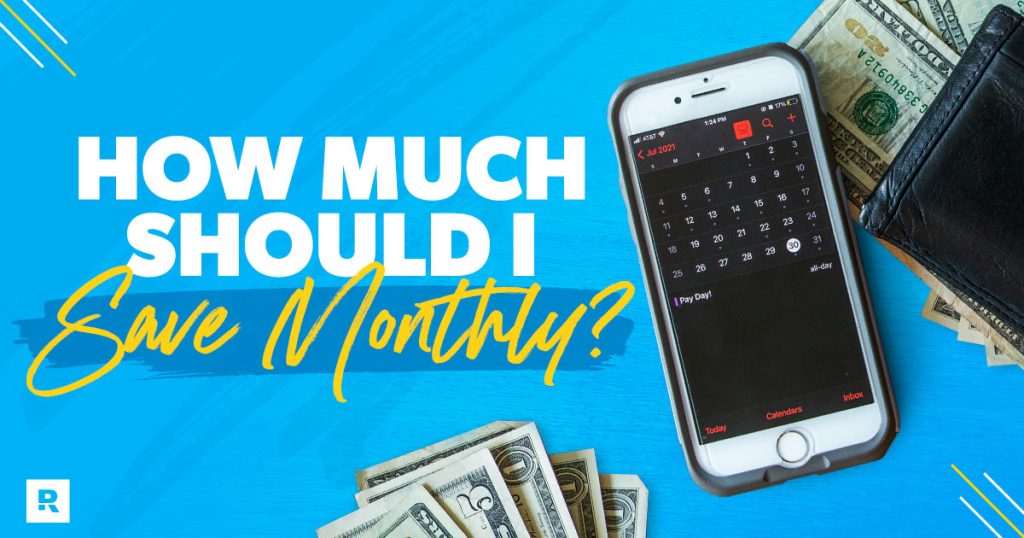How much of my paycheck should I save?
That’s the question on a lot of people’s minds. Matter of fact, a whole bunch of people want to know not only how much to save, but when to save it and where to save it. And I’m here to help!
Basically, how much you should save from your pay depends on your money goals and what matters to you.
The truth is, a lot of people don’t prioritize saving money these days because most of them—78% of Americans—are living paycheck to paycheck.1 That’s bananas!
If you want to be successful at stashing money into savings, you’ve got to do it in a way that also breaks the paycheck-to-paycheck cycle. (Because in case you weren’t sure, your savings isn’t there to prop up bad spending habits.)
So, let me walk you through exactly how to do that!
How Much of My Paycheck Should I Save Each Month?
A lot of money experts swear up and down that you should save at least 20% of your paycheck each month no matter what. Okay, sure—that could be a great savings goal. But does it really work? Last I checked, 33% of Americans had zero dollars saved. And about half of Americans can’t cover a $1,000 emergency. So, what’s missing? I’ll tell you what’s missing: knowing where you are in your financial journey!
For me, the amount you save is not one size fits all. In my experience, it has far more to do with where you are in your financial journey. Sometimes, you might need to save more—or less—than 20%. How does that work? We’ll get to that.
But first up, let’s talk about another popular savings rule you’ve probably heard of—and why it’s not the best option either . . .
The 50/30/20 Rule
The 50/30/20 rule is a way of budgeting that divides up your money into three categories: needs (50%), wants (30%) and savings (20%). Some people love this way of managing their money, but, uh—we’ve got some issues here.
For example, are you in debt? Because if you are, you definitely don’t need to be spending 30% of your income on wants. Or maybe you’re saving for a down payment on a house. Well, depending on how quickly you want to buy, maybe you need to save more than 20%!
Another issue with the whole 50/30/20 concept is how vague it is. There are a lot of spending categories that easily overlap. For instance—is paying more on your debt a want or a need? Is putting aside money for a necessary surgery a need or savings? No sir, I don’t like it. And if a plan lacks clarity, that plan won’t help you become a millionaire. Sorry, not sorry.
What Are Your Savings Goals?
Before you start figuring out how much of your paycheck you should save, you’ve got to know what your money goals are. So that “bruh, I’m just trying to save some money” attitude isn’t going to cut it.
You’ve got to get clear about your big-picture money goals so you can determine the steps you need to take to get there. And that includes when to save money and how much.
So, take some time to really think about your goals and what it’s going to take to reach them. Your savings goals should be six things:
- Written down somewhere
- Specific
- Measurable
- Tied to a deadline
- Your own goals, not your mama’s (at the end of the day, the stronger the why, the stronger the try)
- Not a secret (because life-change rarely happens in secret, and you need the right people providing accountability and encouragement to make real change)
On top of that, how much of your paycheck you should save depends on what Baby Step you’re on. Don’t worry, if you’ve never heard of the Baby Steps, I’m about to lay them out for you.
How Much of My Paycheck Should I Save in Baby Step 1?
This first Baby Step right out of the gate is all about saving up $1,000 as fast as you possibly can. Not $5,000. Not $200. We’re talking 1,000 bucks—not a penny more or less.
Start budgeting with EveryDollar today!
First I gotta say, so many of us struggle with savings. I used to have a very hard time with it. You put the money aside, and then a few weeks later, you pull it out again for a bill or a purchase. Wash, rinse, repeat.
But what I can tell you is, getting disciplined with savings is key to building wealth. And doing it step by step with the budget is what allows you to account for every dollar. So when you plan for money to go to savings (including your starter emergency fund), you won’t need to pull it out again—because you already planned for your other spending.
So, with that in mind, you’re probably wondering, How much of my paycheck should I save in order to accomplish this? As much as you can. The truth is, most folks are able to stack up the cash in 30 days. And they do that by making a budget, cutting back on spending, picking up a side hustle, and selling whatever they’ve got laying around the house.
But let’s keep it real. The question I hear most is, “Jade, is $1,000 really enough?” Honestly, it’s not supposed to be enough! It’s temporary! And having an emergency fund that size will truly help you figure out if a situation is an emergency, something that can wait, or something you can solve at a lower cost.
Then people will ask me, “Jade! What if I have a larger family?” The same reason for keeping your emergency fund at $1,000 also applies for larger families.
Listen, the point of this limit is to make sure you have a mini safety net so you can quickly move to the next Baby Step. But if something does go down and you need more than $1,000, you’ll be shocked at how creative you can get (just don’t use debt). Necessity truly is the mother of invention.
So, maybe you can scale back enough to save $500 from each paycheck and knock this out in a month (that’s awesome!). Or maybe saving even $75 from each paycheck is really stretching it for you. That’s okay too!
Sell some stuff or pick up a side hustle to help you hit the $1,000 mark even faster. And no matter what, get on a budget, make a plan, and stick to it. Before you know it, you’ll have $1,000 saved up for Baby Step 1 and can move on to the next step lickety-split.
How Much of My Paycheck Should I Save in Baby Step 2?
All right, I’m about to say something you’re probably not going to like. But I’m not worried, because if there’s one Baby Step I know about, that’s Baby Step 2. When you’re paying off debt (Baby Step 2), you need to take your savings down to that $1,000 we just talked about and toss any extra money you had saved up onto your debt. Ouch. I know. That one stings a little. But like I said, when it comes to Baby Step 2, I know my stuff. My husband and I paid off $460,000 in consumer debt—and yep, we only had $1,000 in savings when we did it. So, when it comes to this topic, I’m not gonna back down.
Let’s say you have $7,000 in your savings account but you owe $15,000 in student loan debt. Suddenly, the math ain’t mathin’! That $7,000 you feel so good about isn’t really yours, is it? Technically, it belongs to the student loan company.
See, as long as you have debt to your name, that money belongs to someone else. So just go ahead: bite the bullet and pay off $6,000 of your debt. That would drop your debt balance down to four digits, and you’d still have that $1,000 emergency fund as a buffer between you and anything that could go wrong in life. Plus, the sooner you’re out of debt, the sooner you can start saving again! Come on, somebody!
In Baby Step 2, you don’t save money from your paycheck—every extra dollar goes toward getting you out of debt. But let’s clear the air here: Just because you’re in Baby Step 2, that doesn’t mean you can’t save up for those necessary planned expenses with sinking funds (in fact—you should).
A sinking fund is a way to save up for the big expenses you know are coming, like Christmas presents, annual insurance premiums, and even car repairs. The money you put aside in your sinking funds each paycheck shouldn’t add up to a crazy high amount, it’s true—but you can still cash flow planned expenses even while in Baby Step 2.
How Much of My Paycheck Should I Save in Baby Step 3?
You did it! You paid off all your debt and officially made it to Baby Step 3 (saving up 3–6 months of basic expenses in a fully funded emergency fund). This is where you get to really put the pedal to the metal and flex those savings muscles. With no debt payments, imagine how much more of your paycheck could go toward savings—or in this case, a fully stacked emergency fund.
Remember: Even though you’re out of debt now, you’re still in game-on mode and saving every bit of money you can to build your fully funded emergency fund.
Let’s say you were putting $600 from each paycheck toward your debt payments. Well, now that you have zero debt, you can put that $600 from every paycheck toward your fully funded emergency fund. If your emergency fund goal is $12,000, then you’d be able to accomplish that in 18 months. And guess what? The money is all yours because you don’t owe anyone.
How is this one different than the first Baby Step? Well, in Baby Step 3, you’re focused on saving up 3–6 months’ worth of basic expenses. Basically, you’re battening down the hatches and prepping for life’s big storms—like an unexpected job loss. This is the money that will see you through the storm for three to six months if you don’t have a paycheck coming in.
How Much of My Paycheck Should I Save in Baby Step 4 and Beyond?
Baby Step 4 is where your savings habit gets a bit of a makeover. We get to switch it up and begin investing to create a beautiful little thing called compound growth. Now, you’re probably asking yourself, How much of my paycheck should go toward retirement? The answer is at least 15%. Yep, in Baby Step 4, you should invest 15% of your take-home pay in retirement. But you’re not putting that money into a savings account—you need to contribute it to a tax-advantaged retirement account like a 401(k) or a Roth IRA.
And here’s the great thing about setting aside money to invest—that money is going to increase! So even though you might think taking 15% from your paycheck is a pain in the neck, over time, that money is going to grow and grow. And one day (when you’re retired), you’ll be thanking your past self for putting aside that cash.
What a time to be alive!
Where Should I Put My Savings?
Put your savings somewhere you aren’t tempted to spend it. That doesn’t mean you have to bury it in the backyard, but don’t just leave it sitting in your checking account where you could spend it in a second.
Where to Save Your Starter Emergency Fund (Baby Step 1)
Putting the money in a safe, separate savings account is A-okay. If you can find a special savings account that makes you a few bucks a year in interest, cool. But keep in mind, you’re not trying to get rich from the interest here. You just need to keep that $1,000 where you can get to it easily—but not so easily that you constantly dream about spending it. I found that an online bank worked great when Sam and I were on Baby Steps 1 and 2. I recommend one that has next-day transfer options, but no debit card.
Where to Save Your Fully Funded Emergency Fund (Baby Step 3)
When you’ve got the big papa of emergency fund savings on your hands, your best bet is to park that in a money market account. It’ll stay tucked away safe and secure, but you’ll also be able to get to it when you need it with a debit card or a check. I hope for you that’s not too often.
I Can’t Save That Much From My Paycheck—Now What?
I get it. If you’re living paycheck to paycheck and just barely scraping by each month, it’s going to be really hard to find extra money to save. But that doesn’t mean you can’t save. (You can tell me you won’t, but don’t tell me you can’t!)
Here are a few ways you can find extra money to save from your paycheck each month.
Sell Stuff
Take a quick look around your house. I bet you’ll find all kinds of stuff you aren’t using or don’t even like anymore. Sell it and clear out the house! Like they say, “One man’s trash is another man’s treasure.”
You might think that old toddler bed collecting dust in your attic isn’t worth much, but you can probably get $40 for it on Facebook Marketplace or at a garage sale. Hey—you never know until you try. So, spend a Saturday afternoon looking for stuff you can sell to give your savings a big boost.
Take on Another Job
When you need some extra cash, one of the best things to do is get to work. Side hustle, here we come! Okay, so this one is going to take a little more commitment than one Saturday afternoon. But maybe you can work part time three or four times a month to give your savings that extra push. A ton of places hire for part-time work—retail stores always need cashiers, and you can even make your own schedule working for Uber, Lyft or DoorDash.
How much of your paycheck should you save from your second job? Heck, maybe you can save most of it. Wouldn’t that be awesome? And if you’re able to budget your regular income enough to cover all your monthly expenses, there’s no reason why you can’t just dump a big chunk of this paycheck into your savings.
How Can I Put More Money in Savings?
Here’s the thing—you can do all the stuff I’ve talked about, but if you don’t actually have a plan for your money, you won’t get very far. That means you need a budget! Because a budget is just a plan for your money—plain and simple.
And lucky for you, I know just the free budgeting tool you need: EveryDollar. In fact, the average EveryDollar user finds an extra $395 in their first month of budgeting! Download EveryDollar today so you’ll be able to put more of your paycheck toward your savings goals—one monthly budget at a time.
Read the full article here










